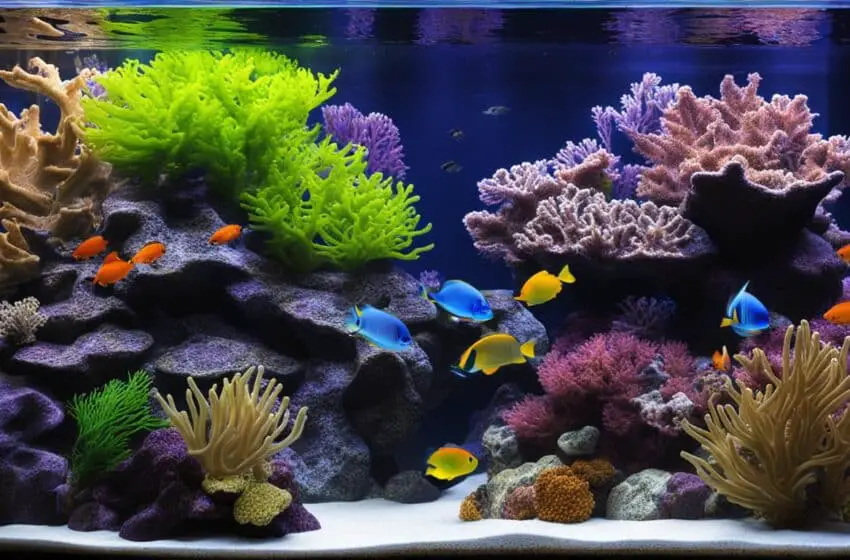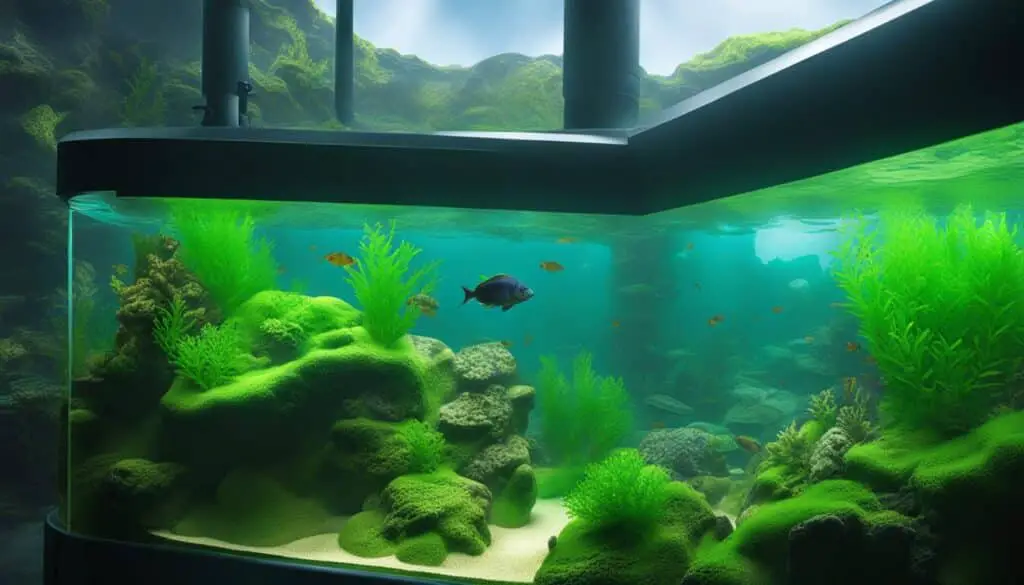The Role of UV Lighting in Algae Control

As an aquarist, one of the challenges you may encounter in maintaining a saltwater aquarium is controlling algae growth. Excessive algae can affect the water quality, aesthetics, and overall health of your marine ecosystem. That’s where UV lighting comes into play.
UV lighting, specifically UV-C radiation, has proven to be an effective tool in suppressing algae growth in saltwater aquariums. It works by damaging the nucleic acid in algae cells, disrupting various aspects of their biology, such as light harvesting and toxin synthesis. This control method is influenced by factors like UV transmissivity, salinity, and pH of the water, as well as the sensitivity of different algae species.
The use of UV LED technology offers advantages over traditional mercury UV lamps. UV LEDs generate no heat, reducing the risk of overheating the aquarium. Additionally, they require less maintenance, as they have a longer lifespan and do not require periodic bulb replacement.
Key Takeaways:
- UV lighting, particularly UV-C radiation, effectively suppresses algae growth in saltwater aquariums.
- UV LED technology offers advantages over traditional mercury UV lamps, including no heat generation and reduced maintenance.
- UV lighting can be used in various applications, such as fish farms, aquariums, and industrial settings, to control algae and protect the environment.
- The effectiveness of UV lighting on algae control is influenced by factors like species sensitivity, UV transmissivity, and water conditions.
- UV clarifiers, when used in combination with other strategies, help maintain water quality and create a balanced ecosystem in your saltwater aquarium.
Understanding Algae in Saltwater Aquariums
Algae are photosynthetic organisms that can thrive in both freshwater and marine environments. They serve as a vital component of the ecosystem, providing a source of food for marine life. However, when algae growth becomes excessive, especially with planktonic and filamentous algae types, it can have detrimental effects on the water quality within saltwater aquariums.
Planktonic algae are microscopic plants that cause green water blooms, making the aquarium water appear cloudy and obstructing visibility. On the other hand, filamentous algae form long, visible threads or mats, compromising the aesthetics of the aquarium and potentially harming its inhabitants.
In the battle against algae overgrowth, UV clarifiers have proven to be effective in controlling planktonic algae. These devices utilize ultraviolet radiation to expose the algae cells, causing damage and inhibiting their growth. However, it is essential to note that UV clarifiers have limited impact on filamentous algae due to their complex structure.
“Excessive growth of algae, particularly planktonic and filamentous types, can negatively impact water quality in saltwater aquariums.”
Understanding the different types of algae in saltwater aquariums is crucial for effective control and maintenance. By being aware of these algae types and their specific challenges, aquarists can develop comprehensive strategies to keep their aquariums clean and visually appealing while ensuring the well-being of their marine inhabitants.
The Benefits of UV Lighting for Algae Control
UV clarifiers play a crucial role in maintaining the water quality in saltwater aquariums by effectively controlling algae growth. When exposed to ultraviolet radiation, algae cells have their cellular walls destroyed, causing them to clump together and be easily removed by mechanical filtration.
UV clarifiers are a valuable tool in maintaining pond water quality because:
- They provide a natural and chemical-free method of algae control.
- They target algae at the cellular level, preventing excessive growth.
- They promote a clear and visually appealing aquarium environment.
- They help maintain a balanced ecosystem by controlling the algae population.
However, to ensure the optimal performance of UV clarifiers, certain maintenance practices need to be followed. It is important to replace the bulbs annually to maintain their effectiveness in controlling algae. Additionally, maintaining an appropriate flow rate is crucial. Running the UV clarifier too fast can damage the unit, while running it too slow can have a sterilizing effect and disrupt the natural bacteria in the aquarium.
UV clarifiers should be used as part of a comprehensive approach to achieving a balanced ecosystem in the aquarium. By combining UV clarifiers with other strategies such as proper mechanical filtration and nutrient management, aquarists can effectively control algae growth, improve pond water quality, and create a healthy, thriving aquarium environment.
Benefits of UV Lighting for Algae Control:
| Benefit | Description |
|---|---|
| Chemical-Free | UV clarifiers provide a natural and chemical-free method of algae control, reducing the need for chemical additives that may harm fish and other aquatic life. |
| Precise Algae Control | UV clarifiers target algae at the cellular level, preventing excessive growth and maintaining a balanced ecosystem. |
| Improved Aesthetics | By controlling algae growth, UV clarifiers help maintain a clear and visually appealing aquarium environment, enhancing the overall aesthetics. |
| Enhanced Ecosystem | UV clarifiers contribute to a balanced ecosystem by controlling the algae population, promoting a healthier environment for fish and other aquatic life. |
Overall, UV clarifiers are a valuable tool in maintaining pond water quality and controlling algae growth in saltwater aquariums. By following proper maintenance practices and incorporating UV clarifiers into a comprehensive approach, aquarists can effectively manage algae and create a thriving aquarium environment.

Achieving Balance in Your Saltwater Aquarium
An algae problem in your saltwater aquarium indicates an imbalance in the ecosystem. While UV lighting can help control algae, it should be considered as a last resort. To address the root cause of the problem, consider implementing the following strategies:
1. Add Beneficial Bacteria
Introducing beneficial bacteria can help reduce organic waste in your aquarium. These bacteria break down excess nutrients that contribute to algae growth, helping to restore the balance in the ecosystem.
2. Promote Aeration
Adequate aeration is essential for maintaining oxygen levels in your aquarium. Increasing the oxygen content can promote the growth of beneficial bacteria and hinder the growth of algae. Consider using an air pump or other aeration devices to enhance the circulation of water.
3. Use Pond Dye
Pond dye can be an effective tool for limiting sunlight penetration in your aquarium. By reducing the amount of available light, pond dye can help inhibit algae growth. Choose a dye that is safe for your fish and follow the manufacturer’s instructions for proper usage.
4. Manage Fish Population
If your aquarium has an excessive fish population, it may contribute to nutrient imbalances and algae growth. Consider finding new homes for some of the fish to ensure a healthy and balanced ecosystem.
5. Practice Nutrient Management
Proper nutrient management is crucial for preventing algae overgrowth. Regularly test the water parameters and adjust feeding and fertilization practices accordingly. Avoid overfeeding your fish and monitor nutrient levels to maintain a healthy and balanced aquarium environment.
By implementing these strategies and maintaining a balanced ecosystem, you can naturally control algae growth and maintain a visually appealing saltwater aquarium.

Conclusion
UV lighting is an essential component of any saltwater aquarium lighting guide, playing a crucial role in algae control and ensuring the maintenance of water quality. By understanding the different types of algae and their susceptibility to UV radiation, aquarists can effectively manage their aquariums and create a healthier habitat for marine life.
UV clarifiers, such as those utilizing UV lighting, can be used in conjunction with other strategies to achieve long-term algae control. A holistic approach that includes promoting a balanced ecosystem, maintaining proper flow rates, and regular maintenance, including bulb replacement, is essential for optimal performance.
By following best practices and implementing these effective measures, aquarists can not only control algae growth but also enhance the overall aesthetics of their marine aquariums. The use of UV lighting, alongside other methods, plays a significant role in achieving a visually appealing and thriving saltwater aquarium environment.
FAQ
How does UV lighting control algae in saltwater aquariums?
UV lighting emits UV-C radiation, which damages algae cells’ nucleic acid and disrupts their biology, including light harvesting and toxin synthesis. This suppresses algae growth in the aquarium.
What factors influence the effectiveness of UV lighting on algae?
The sensitivity of different algae species, UV transmissivity, salinity, and pH of the water can all affect the effectiveness of UV lighting in controlling algae in saltwater aquariums.
What are the advantages of UV LED technology over traditional mercury UV lamps?
UV LED technology generates no heat and reduces maintenance requirements compared to traditional mercury UV lamps. This makes it a more efficient and cost-effective option for algae control in aquariums.
Do UV clarifiers work on all types of algae?
UV clarifiers are effective in controlling planktonic algae, which cause green water blooms. However, they have limited impact on filamentous algae, which form long threads or mats in the aquarium.
How do UV clarifiers maintain water quality in saltwater aquariums?
UV clarifiers destroy the cellular walls of algae cells when exposed to ultraviolet radiation. This causes the algae cells to clump together and be removed by mechanical filtration, improving water quality.
What should I consider when using UV clarifiers in my aquarium?
It is important to replace the UV clarifier bulbs annually and maintain an appropriate flow rate. Running the clarifier too fast can damage the unit, while running it too slow can have a sterilizing effect and disrupt natural bacteria.
Is UV lighting the only solution for algae control in saltwater aquariums?
While UV lighting is an effective tool, it should be considered as a last resort. Addressing the root cause of the algae problem, such as adding beneficial bacteria, promoting aeration, and managing nutrient levels, is key to achieving long-term algae control.
How can I achieve balance in my saltwater aquarium?
To achieve balance, consider adding beneficial bacteria to reduce organic waste, promoting aeration to enhance oxygen levels, using pond dye to limit sunlight penetration, and managing the fish population and nutrient levels in the aquarium.
How important is maintenance for UV clarifiers?
Regular maintenance, including bulb replacement and proper flow rate management, is essential for the optimal performance of UV clarifiers in controlling algae and maintaining water quality in saltwater aquariums.



